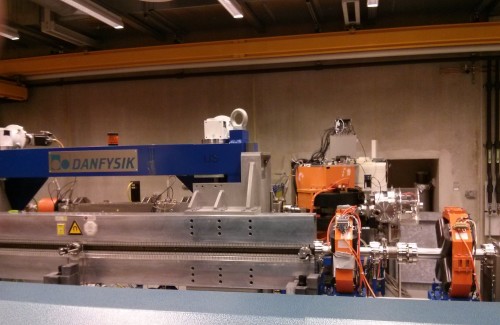
Wiggling electrons: an undulator at one of FELIX’s free-electron lasers.
By Tim Wogan in Nijmegen, the Netherlands
Tucked away near the German border is the Dutch city of Nijmegen and Radboud University, which has a treasure trove of fantastical physics facilities. I was in town for a two-day, whistle-stop tour of the university that included the the opening of the FELIX facility. FELIX stands for “free-electron laser for infrared experiments laboratory”. It is a cavernous chamber housing four free-electron lasers that together can generate high-intensity, tunable radiation with wavelengths anywhere between 3–1500 μm. Something, I was told, that is possible nowhere else in the world.
The image above is of an undulator from one of FELIX’s four free-electron lasers. An electron beam enters from the right, after which successive magnets with opposite polarity deflect it repeatedly left and right in a series of wiggles or undulations that create the synchrotron radiation. Radiation from successive undulations interferes either constructively or destructively depending on whether it is in or out of phase. This produces a series of ultrashort pulses with a period of one optical wavelength, which exit just out of the picture on the left.
The folks at Radboud also showed me around some of their other facilities, including the newly constructed ATOMS lab at the Scanning Probe Microscopy laboratory. Resembling the lair of a James Bond villain, the lab is built deep underground on springs to cushion the ultra-sensitive experiments against all external vibrations. My genial host was the head of the lab, Alexander Khajetoorians, who tells me that it’s the quietest room in the Netherlands. It wasn’t very quiet when I was there because a group of us were jumping up and down on the floor to watch it move.
Another highlight of the tour was the High Field Magnet Laboratory, which generates some of the highest magnetic fields of any facility in the world – up to 37.5 T. The lab also has the unique distinction of being connected to FELIX, which allows scientists to study matter being zapped by intense coherent light and high magnetic fields at the same time. In keeping with the Bond theme, a Byzantine beam pipe guides the laser light from FELIX to the lab.
Unlike the microscope lab, the magnet facility is very noisy, with lots of banging and crashing going on. This is not ideal during nap times at the children’s nursery next door. That’s why the facility is muffled with a carefully constructed mesh that filters out the offending sounds so they don’t reach the children’s ears.
Trackback: Making noise in the quietest room in the Netherlands – MyPhysNet